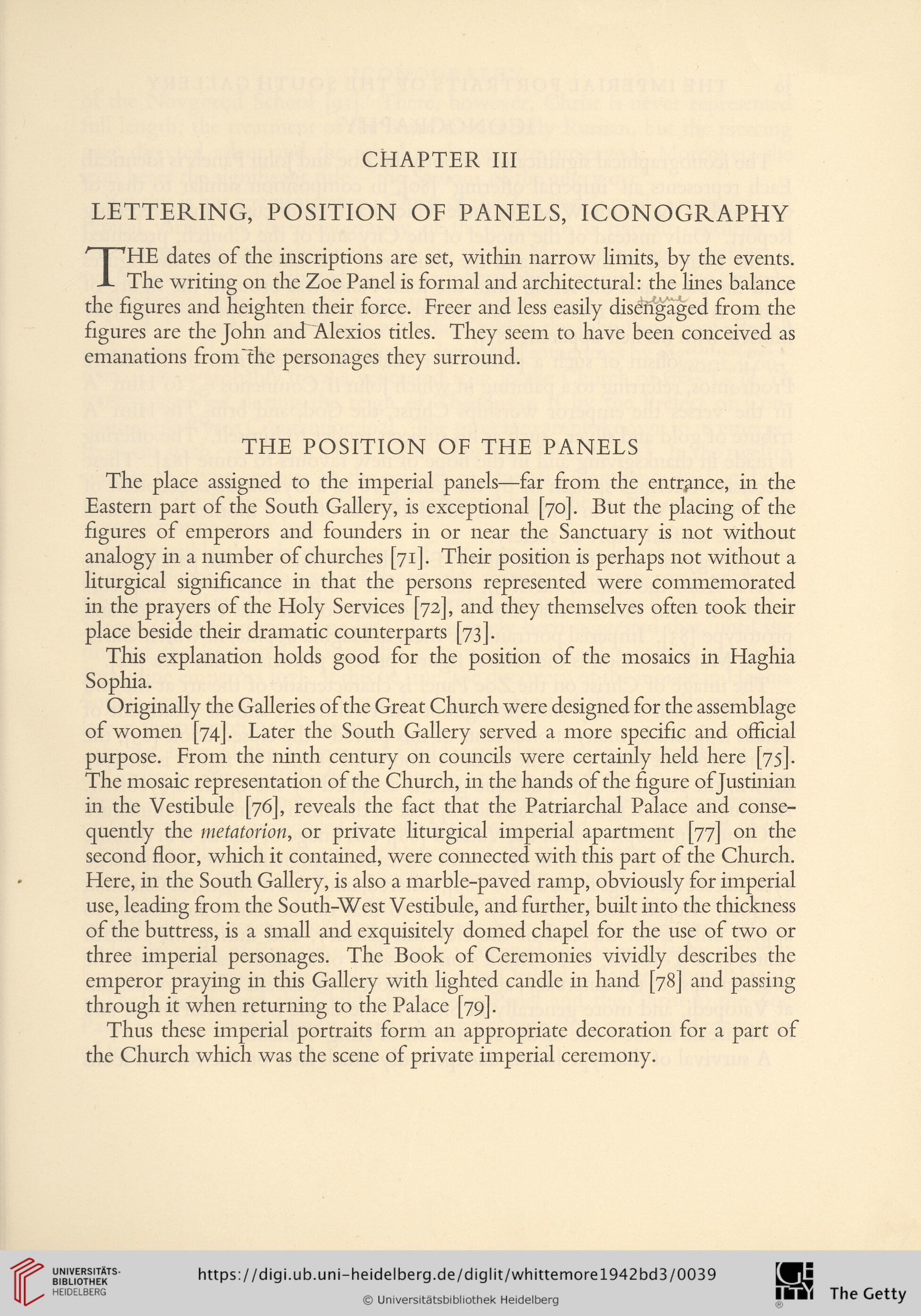CHAPTER III
LETTERING, POSITION OF PANELS, ICONOGRAPHY
i^HE dates of the inscriptions are set, within narrow limits, by the events.
The writing on the Zoe Panel is formal and architectural: the lines balance
the figures and heighten their force. Freer and less easily disengaged from the
figures are the John and Alexios titles. They seem to have been conceived as
emanations from'the personages they surround.
THE POSITION OF THE PANELS
The place assigned to the imperial panels—far from the entrance, in the
Eastern part of the South Gallery, is exceptional [70]. But the placing of the
figures of emperors and founders in or near the Sanctuary is not without
analogy in a number of churches [71]. Their position is perhaps not without a
liturgical significance in that the persons represented were commemorated
in the prayers of the Holy Services [72], and they themselves often took their
place beside their dramatic counterparts [73].
This explanation holds good for the position of the mosaics in Haghia
Sophia.
Originally the Galleries of the Great Church were designed for the assemblage
of women [74]. Later the South Gallery served a more specific and official
purpose. From the ninth century on councils were certainly held here [75].
The mosaic representation of the Church, in the hands of the figure of Justinian
in the Vestibule [76], reveals the fact that the Patriarchal Palace and conse-
quently the metatorion, or private liturgical imperial apartment [77] on the
second floor, which it contained, were connected with this part of the Church.
Here, in the South Gallery, is also a marble-paved ramp, obviously for imperial
use, leading from the South-West Vestibule, and further, built into the thickness
of the buttress, is a small and exquisitely domed chapel for the use of two or
three imperial personages. The Book of Ceremonies vividly describes the
emperor praying in this Gallery with lighted candle in hand [78] and passing
through it when returning to the Palace [79].
Thus these imperial portraits form an appropriate decoration for a part of
the Church which was the scene of private imperial ceremony.
LETTERING, POSITION OF PANELS, ICONOGRAPHY
i^HE dates of the inscriptions are set, within narrow limits, by the events.
The writing on the Zoe Panel is formal and architectural: the lines balance
the figures and heighten their force. Freer and less easily disengaged from the
figures are the John and Alexios titles. They seem to have been conceived as
emanations from'the personages they surround.
THE POSITION OF THE PANELS
The place assigned to the imperial panels—far from the entrance, in the
Eastern part of the South Gallery, is exceptional [70]. But the placing of the
figures of emperors and founders in or near the Sanctuary is not without
analogy in a number of churches [71]. Their position is perhaps not without a
liturgical significance in that the persons represented were commemorated
in the prayers of the Holy Services [72], and they themselves often took their
place beside their dramatic counterparts [73].
This explanation holds good for the position of the mosaics in Haghia
Sophia.
Originally the Galleries of the Great Church were designed for the assemblage
of women [74]. Later the South Gallery served a more specific and official
purpose. From the ninth century on councils were certainly held here [75].
The mosaic representation of the Church, in the hands of the figure of Justinian
in the Vestibule [76], reveals the fact that the Patriarchal Palace and conse-
quently the metatorion, or private liturgical imperial apartment [77] on the
second floor, which it contained, were connected with this part of the Church.
Here, in the South Gallery, is also a marble-paved ramp, obviously for imperial
use, leading from the South-West Vestibule, and further, built into the thickness
of the buttress, is a small and exquisitely domed chapel for the use of two or
three imperial personages. The Book of Ceremonies vividly describes the
emperor praying in this Gallery with lighted candle in hand [78] and passing
through it when returning to the Palace [79].
Thus these imperial portraits form an appropriate decoration for a part of
the Church which was the scene of private imperial ceremony.




